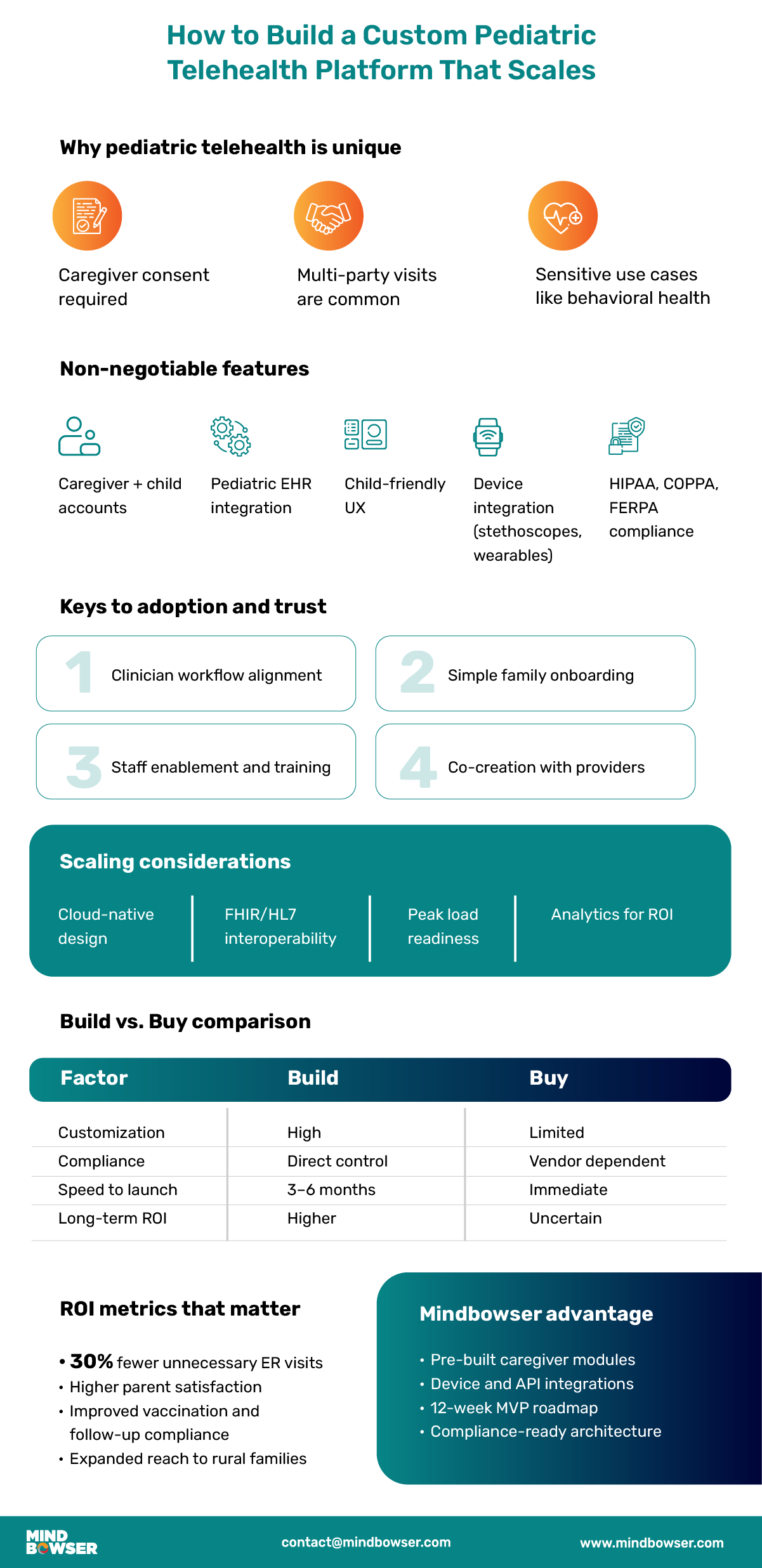When hospital leaders or startup founders ask if they can extend an adult telehealth system to pediatrics, my answer is simple: not without compromise. Pediatric care introduces complexities that are absent in adult workflows.
Pediatric visits often involve parents, guardians, or multiple caregivers. Platforms must accommodate proxy accounts, shared scheduling, and clear consent pathways.
A typical session may include the child, a parent, a pediatrician, and in some cases a subspecialist. Systems built for one-to-one encounters fall short in this environment.
Pediatric telehealth frequently supports behavioral health, chronic disease management, and triage for acute issues. These require nuanced workflows and escalation protocols that differ from those used in adult telemedicine.
Key Takeaway: Scaling pediatric telehealth is not about stretching adult systems. It requires a purpose-built design that reflects the realities of family-centered care.
Based on my experience working with health systems and startups, pediatric telehealth requires more than just video conferencing. Success comes when the platform is designed with pediatric-specific needs in mind. Leaders evaluating or building solutions should ensure the following capabilities are in place:
Pediatric encounters almost always involve a parent or guardian. Platforms need a way to manage consent, allow proxy logins, and support shared scheduling. Without this, families face unnecessary friction before the visit even begins.
Unlike adult care, pediatrics relies on features such as growth charts, immunization records, and weight-based dosing. A platform that does not integrate with the EHR risks creating duplicate data entry for clinicians and gaps in a child’s longitudinal record.
Pediatric visits often require the presence of more than one participant. A provider may need to bring in a behavioral health specialist or a nutritionist while the caregiver remains on the call. Platforms limited to one-to-one video do not meet these clinical realities.
Children are not small adults. Anxiety and distraction are common, so a telehealth platform should incorporate a pediatric-friendly design. Animated waiting rooms, gamification elements, or calming visuals help reduce fear and keep young patients engaged.
Tools such as digital otoscopes, stethoscopes, and wearable devices are becoming increasingly integral to pediatric virtual care. Seamless integration ensures that clinicians can capture vitals and other clinical data during the visit without having to juggle disconnected apps.
In pediatrics, compliance must account for HIPAA and COPPA; in school-based programs, FERPA may also apply. Families need confidence that their child’s data is protected. Leaders should treat this as a foundation, not an afterthought.
Bottom Line: Without these features, adoption will lag both for clinicians and for families. A pediatric telehealth platform must be designed to meet the unique needs of children, their caregivers, and healthcare providers.

A telehealth platform may have advanced features, but it holds little value if clinicians hesitate to use it or if families lack confidence in it. Adoption is not automatic. It must be earned through thoughtful design and reliable performance.
Physicians and nurses already manage packed schedules and complex documentation requirements. If telehealth adds more clicks or creates duplicate work, they will resist. Platforms must integrate with the EHR, streamline documentation, and fit naturally into the daily workflow. When providers see that the system saves them time instead of adding burden, adoption grows quickly.
Parents will not embrace a platform that is confusing or unreliable. The login process should be simple, the interface should be intuitive, and the connection should be stable. Families also want reassurance that their child’s information is safe. Clear communication about HIPAA and COPPA protections builds confidence.
3. Enablement Through Support and Training
Even the best technology can fail without human support. Hospitals that succeed with pediatric telehealth invest in training for clinicians and onboarding for families. Some organizations utilize pediatric nurse navigators or telepresenters to guide families through their initial visits. This type of enablement reduces drop-off and normalizes virtual care for both sides.
4. Design with Co-creation
Adoption improves when clinicians and caregivers are included in the design process. Platforms shaped by real-world feedback tend to be more intuitive and practical. Early pilots that gather input from frontline providers and families often determine whether scaling will succeed.
Key Insight: Adoption is not just about the technology itself. It is about building confidence that the platform works reliably, keeps children safe, and reduces complexity for both clinicians and families.
Related read: How to Build a Telemedicine Platform: Complete Guide for HealthTech Startups
Many pediatric telehealth initiatives begin with a pilot, typically within a single department or specialty. While pilots are useful for proving value, too many fail when expanded across multiple sites or service lines. Leaders often underestimate the technical and operational demands that come with scaling. A platform built for pediatrics must be ready for growth from day one.
Platforms that rely on on-premise systems struggle as demand grows. Cloud-native design allows organizations to support multiple locations, expand to new geographies, and adjust capacity quickly. This flexibility ensures performance remains consistent even during rapid growth.
A pediatric telehealth platform does not operate in isolation. It must work seamlessly with EHRs, scheduling systems, billing platforms, and clinical data repositories. Standards such as FHIR and HL7 facilitate smoother integration, and SMART on FHIR applications enable pediatric-specific modules to seamlessly integrate with broader hospital systems.
Related read: Interoperability and Electronic Prescription System
Pediatric demand can be seasonal. Back-to-school periods, flu season, or regional outbreaks can lead to sudden spikes in visit volume. Leaders must plan for load balancing, redundancy, and disaster recovery to ensure optimal system performance. Platforms that cannot manage these surges risk frustrating families and overwhelming clinicians.
Scaling is not only about technology but also about decision-making. Analytics should provide visibility into key metrics such as utilization rates, no-show patterns, average wait times, and clinical outcomes. These insights guide staffing models, identify bottlenecks, and demonstrate ROI to boards and investors.
Growth requires more than server capacity. Hospitals and startups must also expand support staff, refine training, and adjust workflows. Scalability succeeds when technology and operations move in lockstep.
Bottom Line: Scalability in pediatric telehealth is not just a technical challenge; it is a multifaceted issue. It is a comprehensive effort that requires robust architecture, deep integration, operational planning, and the ability to adapt to unpredictable demand.
When organizations decide to launch pediatric telehealth, one of the earliest questions is whether to build a custom solution or buy an existing vendor platform. Both paths have benefits and tradeoffs. The right choice depends on long-term goals, regulatory requirements, and the degree of customization needed for pediatric care.
Hybrid Approach: Increasingly, organizations choose a hybrid path. They leverage accelerators and pre-built modules to reduce cost and time while still building a custom foundation. This approach strikes a balance between speed and flexibility, providing organizations with control without requiring a complete overhaul from scratch.
Key Insight: Leaders should view the build-versus-buy decision through the lens of scalability and long-term pediatric care. Quick wins may come from vendor platforms, but sustained growth often requires custom solutions tailored to the needs of children and families.
For pediatric telehealth, the financial case is just as important as the clinical one. Boards, investors, and operational leaders want to see evidence that the program improves outcomes while supporting sustainability. The right ROI metrics enable you to demonstrate both impact and value.
One of the most significant benefits is avoiding non-urgent ER visits. Pediatric telehealth allows families to consult a provider quickly for issues that do not require emergency care. For hospitals, this reduces strain on emergency services and lowers costs. For payers and families, it avoids high out-of-pocket expenses.
Missed appointments are a longstanding challenge in pediatrics, particularly for families balancing work, transportation, and childcare. Telehealth makes it easier to schedule follow-up visits, manage chronic conditions, and stay up to date with vaccinations. Better adherence translates into improved outcomes and reduced long-term costs.
3. Parent Satisfaction and Loyalty
Families that have positive telehealth experiences are more likely to remain loyal to the health system or platform that provided them. Satisfaction scores, Net Promoter Scores, and repeat usage rates all reflect whether a pediatric telehealth program is resonating with parents.
4. Clinician Productivity and Efficiency
Telehealth can increase the number of patients a provider can see in a day while reducing idle time from no-shows. Productivity metrics should track the average number of visits per provider, visit duration, and the impact on overall clinical throughput.
5. Revenue Growth Through Expanded Access
Pediatric telehealth removes geographic barriers, enabling hospitals and startups to serve families outside their immediate area. This expansion can open new revenue streams while also addressing access gaps for rural or underserved populations.
Key Insight: Pediatric telehealth ROI goes beyond cost savings. It reflects a combination of clinical efficiency, patient loyalty, and expanded market reach. Leaders who track these metrics can make stronger cases for continued investment and growth.
Hospitals and startups often underestimate the effort needed to build pediatric telehealth platforms from scratch. Requirements such as caregiver consent, child-friendly UX, device integration, and regulatory compliance make development more complex than a standard telehealth build. At Mindbowser, we created a Pediatric Telehealth Accelerator to help organizations overcome these hurdles and move quickly from concept to scale.
Consent is central in pediatrics. Our accelerator includes pre-configured caregiver portals and proxy login features, allowing parents or guardians to manage appointments, authorize visits, and access records on behalf of their children. This saves months of custom coding and avoids compliance missteps.
Many pediatric visits rely on peripheral devices, such as otoscopes, stethoscopes, and wearable monitors. Our modules enable the easy integration of these tools, allowing clinicians to capture accurate vitals and conduct thorough virtual exams without disrupting the visit.
Regulations such as HIPAA, COPPA, and FERPA set a high bar for pediatric telehealth. Our platform components are built with these standards in mind, reducing the risk of costly delays and ensuring systems are audit-ready from day one.
Instead of spending 12 to 18 months on a full build, our approach delivers a working minimum viable product in as little as 12 weeks. This enables leaders to validate the platform in real-world pediatric care, refine it based on clinician and family feedback, and then scale it systematically.
For organizations seeking advanced features, we offer optional add-ons, including symptom triage chatbots, real-time translation for multilingual families, and adherence reminders. These capabilities enhance access and foster engagement without necessitating new development from scratch.
Outcome: By combining pre-built components with custom flexibility, Mindbowser helps partners avoid reinventing the wheel. The result is a compliant and scalable pediatric telehealth platform that can transition from pilot to enterprise rollout far faster than traditional development timelines allow.

Pediatric telehealth will only succeed at scale when platforms are designed specifically for children, their caregivers, and the clinicians who care for them. Off-the-shelf tools can support basic encounters, but custom builds are necessary to handle caregiver consent, multi-party visits, pediatric-specific EHR integration, and child-friendly design. Scalability depends on getting the foundation right with secure architecture, interoperability, and thoughtful workflows that build trust.
At Mindbowser, we see that leaders who invest in custom pediatric telehealth platforms realize stronger adoption and measurable ROI. With our accelerators and compliance-ready modules, organizations can shorten timelines, reduce risk, and expand access for families more efficiently. The future of pediatric care will be hybrid, and those who build the right digital infrastructure today will be positioned to serve children and families more effectively tomorrow.
Pediatric telehealth must account for caregiver consent, proxy logins, and the involvement of multiple participants in a single visit. It also supports sensitive use cases such as behavioral health and chronic condition management that require customized workflows.
Core features include caregiver and child accounts, pediatric EHR integration, multi-party video, child-friendly interfaces, device integration, and compliance with HIPAA, COPPA, and FERPA. These features ensure adoption by both clinicians and families.
Key metrics include reduced emergency department visits, improved compliance with follow-up and preventive care, parent satisfaction scores, clinician productivity, and expanded access to new patient populations.
Traditional builds can take more than a year, but with accelerators and pre-built modules, a minimum viable product can be deployed in about 12 weeks. This allows organizations to test, refine, and scale more effectively.

We worked with Mindbowser on a design sprint, and their team did an awesome job. They really helped us shape the look and feel of our web app and gave us a clean, thoughtful design that our build team could...


The team at Mindbowser was highly professional, patient, and collaborative throughout our engagement. They struck the right balance between offering guidance and taking direction, which made the development process smooth. Although our project wasn’t related to healthcare, we clearly benefited...

Founder, Texas Ranch Security

Mindbowser played a crucial role in helping us bring everything together into a unified, cohesive product. Their commitment to industry-standard coding practices made an enormous difference, allowing developers to seamlessly transition in and out of the project without any confusion....

CEO, MarketsAI

I'm thrilled to be partnering with Mindbowser on our journey with TravelRite. The collaboration has been exceptional, and I’m truly grateful for the dedication and expertise the team has brought to the development process. Their commitment to our mission is...

Founder & CEO, TravelRite

The Mindbowser team's professionalism consistently impressed me. Their commitment to quality shone through in every aspect of the project. They truly went the extra mile, ensuring they understood our needs perfectly and were always willing to invest the time to...

CTO, New Day Therapeutics

I collaborated with Mindbowser for several years on a complex SaaS platform project. They took over a partially completed project and successfully transformed it into a fully functional and robust platform. Throughout the entire process, the quality of their work...

President, E.B. Carlson

Mindbowser and team are professional, talented and very responsive. They got us through a challenging situation with our IOT product successfully. They will be our go to dev team going forward.

Founder, Cascada

Amazing team to work with. Very responsive and very skilled in both front and backend engineering. Looking forward to our next project together.

Co-Founder, Emerge

The team is great to work with. Very professional, on task, and efficient.

Founder, PeriopMD

I can not express enough how pleased we are with the whole team. From the first call and meeting, they took our vision and ran with it. Communication was easy and everyone was flexible to our schedule. I’m excited to...

Founder, Seeke

We had very close go live timeline and Mindbowser team got us live a month before.

CEO, BuyNow WorldWide

Mindbowser brought in a team of skilled developers who were easy to work with and deeply committed to the project. If you're looking for reliable, high-quality development support, I’d absolutely recommend them.

Founder, Teach Reach

Mindbowser built both iOS and Android apps for Mindworks, that have stood the test of time. 5 years later they still function quite beautifully. Their team always met their objectives and I'm very happy with the end result. Thank you!

Founder, Mindworks

Mindbowser has delivered a much better quality product than our previous tech vendors. Our product is stable and passed Well Architected Framework Review from AWS.

CEO, PurpleAnt

I am happy to share that we got USD 10k in cloud credits courtesy of our friends at Mindbowser. Thank you Pravin and Ayush, this means a lot to us.

CTO, Shortlist

Mindbowser is one of the reasons that our app is successful. These guys have been a great team.

Founder & CEO, MangoMirror

Kudos for all your hard work and diligence on the Telehealth platform project. You made it possible.

CEO, ThriveHealth

Mindbowser helped us build an awesome iOS app to bring balance to people’s lives.

CEO, SMILINGMIND

They were a very responsive team! Extremely easy to communicate and work with!

Founder & CEO, TotTech

We’ve had very little-to-no hiccups at all—it’s been a really pleasurable experience.

Co-Founder, TEAM8s

Mindbowser was very helpful with explaining the development process and started quickly on the project.

Executive Director of Product Development, Innovation Lab

The greatest benefit we got from Mindbowser is the expertise. Their team has developed apps in all different industries with all types of social proofs.

Co-Founder, Vesica

Mindbowser is professional, efficient and thorough.

Consultant, XPRIZE

Very committed, they create beautiful apps and are very benevolent. They have brilliant Ideas.

Founder, S.T.A.R.S of Wellness

Mindbowser was great; they listened to us a lot and helped us hone in on the actual idea of the app. They had put together fantastic wireframes for us.

Co-Founder, Flat Earth

Mindbowser was incredibly responsive and understood exactly what I needed. They matched me with the perfect team member who not only grasped my vision but executed it flawlessly. The entire experience felt collaborative, efficient, and truly aligned with my goals.

Founder, Child Life On Call

The team from Mindbowser stayed on task, asked the right questions, and completed the required tasks in a timely fashion! Strong work team!

CEO, SDOH2Health LLC

Mindbowser was easy to work with and hit the ground running, immediately feeling like part of our team.

CEO, Stealth Startup

Mindbowser was an excellent partner in developing my fitness app. They were patient, attentive, & understood my business needs. The end product exceeded my expectations. Thrilled to share it globally.

Owner, Phalanx

Mindbowser's expertise in tech, process & mobile development made them our choice for our app. The team was dedicated to the process & delivered high-quality features on time. They also gave valuable industry advice. Highly recommend them for app development...

Co-Founder, Fox&Fork
